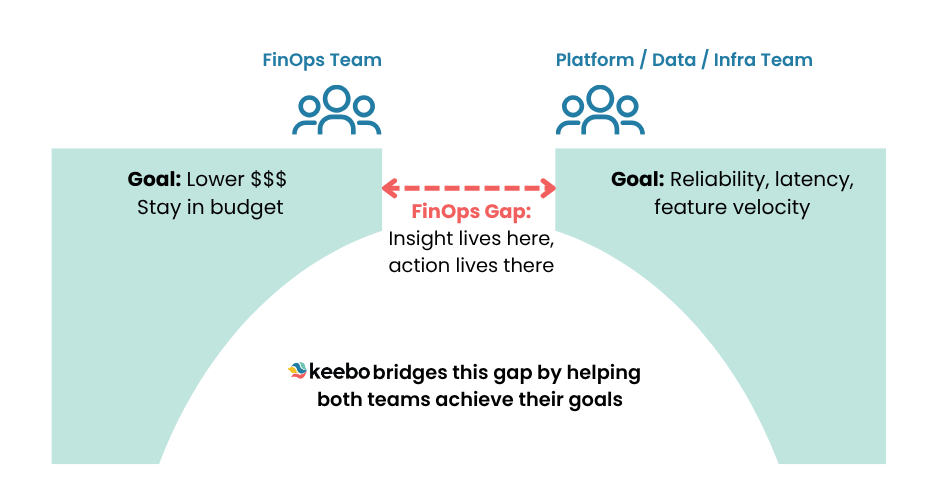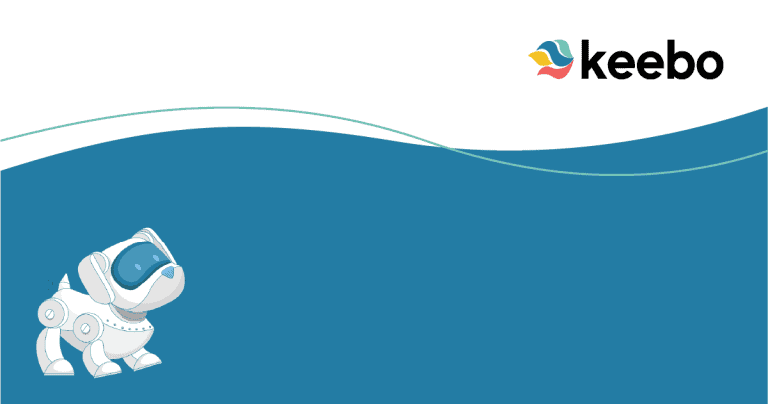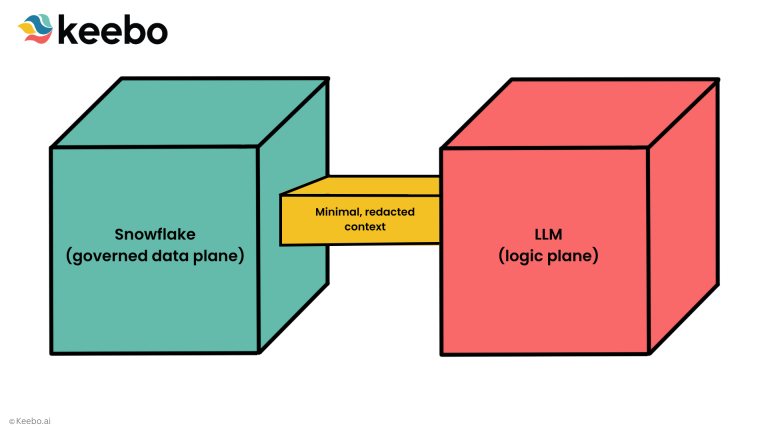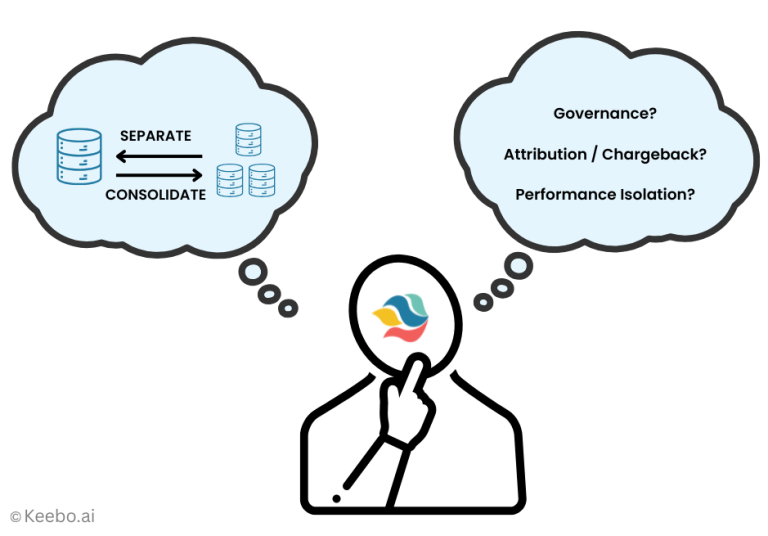Why Execution Is the Next Frontier in FinOps | Keebo
Despite what many believe, the biggest problem facing FinOps teams is not visibility — it’s execution. Modern platforms make it easy to surface cost drivers, yet the people who discover waste rarely control the levers that shrink the bill. Those levers — instance sizes, query tuning, architecture choices — sit with platform and engineering groups whose KPIs revolve around reliability, latency, and shipping features. Two teams, two scorecards, and cost‑saving tickets that never quite reach the top of the sprint.
1. The Execution Gap: How It Happens and Why It Matters
Cost management in the cloud is a relay race with no baton hand‑off. FinOps professionals excel at forecasting, allocation, and anomaly detection, but every optimization still requires engineering work — schema changes, warehouse right‑sizes, pipeline refactors. Engineers, meanwhile, are measured on service‑level objectives and velocity in shipping product features. A ticket that trims $5K a month competes with one that unblocks a feature release; guess which wins.

When incentives diverge, cost‑cutting becomes much harder. The team accountable for the savings can’t touch the knobs, while the team that owns the knobs is chasing uptime and release dates—so overspend just rolls on, month after month.
2. The Evidence: What the Surveys Tell Us
This mis‑alignment isn’t anecdotal. The FinOps Foundation’s latest State of FinOps survey shows that 40% of practitioners rank “getting engineers to take action on cost‑saving recommendations” as their #1 challenge.
Even more telling: in 2024 the top reported priority shifted from “empowering engineers to act” to “reducing unused resources” — a sign that teams still struggle to translate insights into fixes at scale. In other words, dashboards have matured faster than processes, leaving a yawning execution gap.
3. Execution‑First FinOps: Why Pretty Dashboards Don’t Cut It Anymore
Closing that gap demands more than pretty dashboards. An execution‑first platform must weave optimization into the engineering workflow so cost fixes stop competing with feature work.
- Precise diagnostics. Surface waste at the workload, query, or warehouse level so engineers know exactly what to change.
- Safe automation. Apply high‑confidence optimizations — like warehouse right‑sizing — automatically, with built‑in guardrails so there is no risk of violating performance SLAs. Manual solutions rarely work and never scale.
- Low‑effort, high‑ROI tasks. Package the remaining fixes into bite‑sized tickets that take minutes, not days, to land.
- Shared metrics. Track blended KPIs such as cost per job or cost per team so both teams celebrate the same wins.
- Governance by policy. Let organizations toggle between autopilot, recommendation-mode, or hybrid modes as confidence and culture evolve.
- Democratize data but centralize governance. Modern cloud services have democratized access to data, where IT teams are no longer the bottleneck. However, maintaining centralized governance is key to not just compliance but also efficient consumption. For example, smart query routing ensures organizational resources are used efficiently and at the same time frees up engineers to focus on writing correct queries (and delivering features) instead of worrying about cost or performance.
When optimization is this frictionless, cost reduction becomes a by‑product of normal engineering practice, not a special project.
4. Case Study: How Cimpress Turned Insight into Savings Without Effort
Cimpress — parent company of VistaPrint and National Pen — runs one of the most complex, decentralised Snowflake estates in the industry. Complexity bred cost waste and manual toil.
Pre‑Keebo pain points
- Thousands of failed queries and 12,000 unused tables inflated Snowflake spend and obscured visibility.
- Engineers spent hours each week tuning warehouses and chasing rogue workloads instead of shipping features.
Keebo’s execution‑first solution
A lightweight agent observed every query, right‑sized compute, rerouted hotspots, and surfaced optimizations — all via metadata, with zero customer‑data access. Cimpress chose a hybrid governance mode: autopilot for safe changes, approvals for everything else.
Results & lessons
- 3,000 + engineering hours reclaimed annually — automation replaced manual reviews, freeing engineers for product work.
- 15% Snowflake savings driven by eliminating failed queries and unused tables.
- Six internal teams now manage cost and performance autonomously, proving that low‑friction tooling scales across business units.
- Validation of internal tools: Keebo’s insights benchmarked Cimpress’s own Snowflake Information Tool (SIFT), boosting confidence in both systems.
Cimpress’s takeaway: when execution is automated or trivial, cost and velocity can improve together — no trade‑offs required.
5. How Keebo Bridges the Gap Every Day
Keebo bridges your FinOps dashboards and production workloads:
- Observe: capture query‑level metadata in real time (no customer data).
- Optimize: auto‑apply safe fixes through Keebo’s Warehouse Optimization (KWO) or push a curated to‑do list into the engineering backlog through Keebo’s Workload Intelligence (KWI).
- Validate: feed savings, performance deltas, and time‑saved metrics back to both FinOps and engineering dashboards.
Teams can start in recommendation mode and graduate to full autopilot as trust builds, ensuring governance never slows delivery. They can also centralize governance if and as needed through Keebo’s Query Routing (KQR).
6. Next Steps for FinOps & Engineering/Infra Leaders
- Audit your gap. Measure the cycle time between identifying waste and landing fixes.
- Align incentives. Add an efficiency OKR to the platform team’s scorecard.
- Automate the obvious. Let software handle right‑sizing and orphan cleanup; reserve human cycles for architecture shifts.
- Start small, scale fast. Target one noisy warehouse, prove the ROI, then expand coverage.
Call to action: If your dashboards still outpace your ability to act, explore execution‑first automation. Read the full Cimpress case study or try Keebo for free to see how you can help your teams close the gap.



